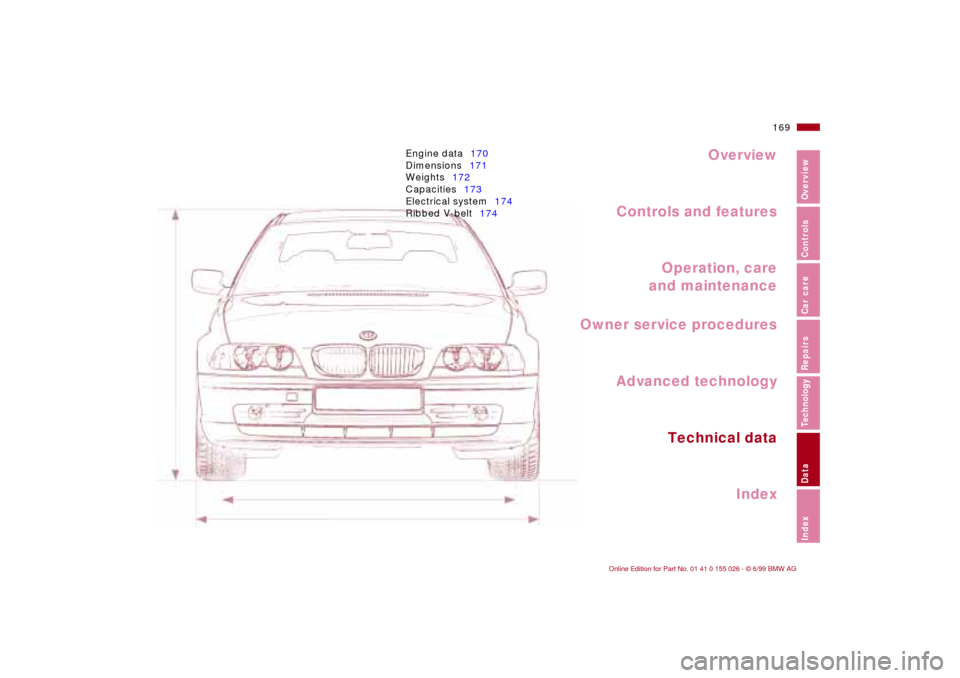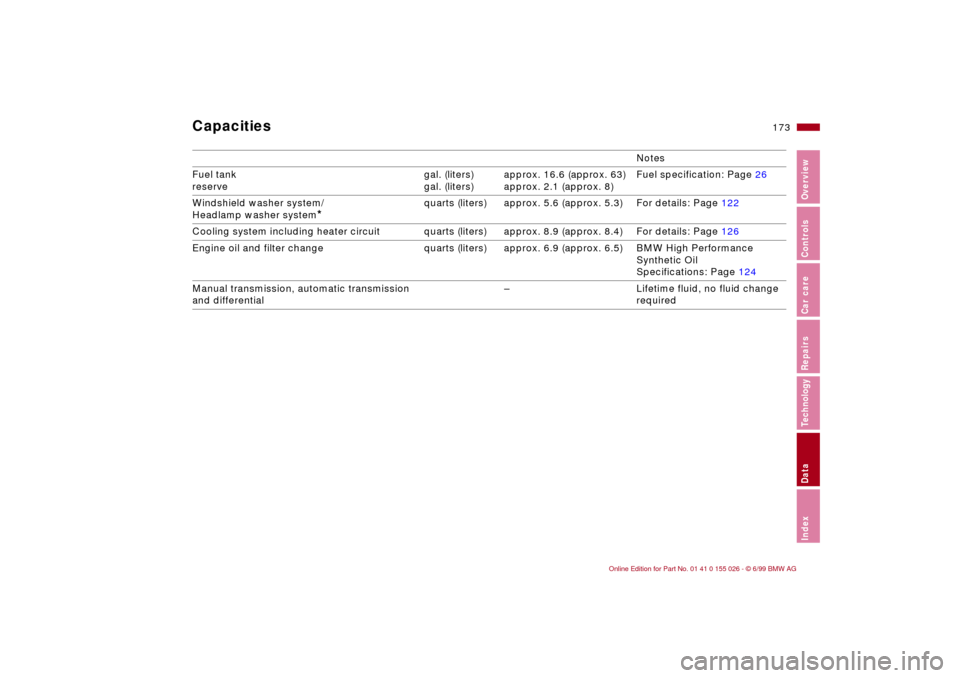2000 BMW 328Ci COUPE engine
[x] Cancel search: enginePage 163 of 189

161n
RepairsIndexOverview Controls Car care Technology Data
Deceleration sensors continuously
monitor the physical forces acting upon
the vehicle. If, as the result of a frontal
collision, a deceleration is reached at
which the protection of the safety belts
alone is no longer adequate, the gas
generators of the driver and passenger-
front airbags are ignited. However, the
passenger-side airbag is only triggered
if an additional sensor has recognized
that the passenger seat is occupied.
In the event of a side collision, the Head
Protection and side airbags in the front
or rear
* are triggered if necessary.
390de319
The airbags located under the marked
covers inflate and unfold in a matter of a
few milliseconds. In this process they
tear through the rated breaking points
of the upholstered covers or press them
out.
Because the inflation process must be
virtually instantaneous, it is necessarily
accompanied by a certain amount of
ignition and inflation noise. The gas
required to inflate the airbags is not
dangerous, and the associated smoke
then dissipates.
The entire process is completed within
fractions of a second.Highly sensitive sensors monitor the
number of revolutions of the wheels,
steering angle, lateral acceleration,
brake pressure and the movement of
the vehicle around its vertical axis.
If differences in the wheel speeds oc-
cur, the system counteracts the danger
of wheelspin by reducing engine torque.
If necessary, the system also responds
with additional application of the brakes
at the rear wheels.
If the system detects an instability in the
vehicle's condition, the braking action
can also be directed to the front wheels
by the DSC in order to help stabilize the
vehicle.
You may need some time to become
accustomed to this system's interven-
tion. However, it provides optimum pro-
pulsive force and driving stability.
The braking intervention may be ac-
companied by a certain degree of
noise.
Airbags DSC
Page 168 of 189

166n
Self-diagnostics All of the important electrical and elec-
tronic systems in the vehicle are tested
regularly and automatically – the driver
does not have to perform any extra op-
erations or adjustments.
The indicator lamps also come on briefly
after the ignition has been turned on.
While you are driving, the functional
status of the actuator motors (for the
windshield wipers, power windows,
seats, sunroof, etc.) is constantly ana-
lyzed by current measurements in their
relays. 462de258
In the same manner, the electrical resis-
tance of the airbag ignition generators
and all of the remaining airbag compo-
nents is measured at all times. Any fault
in this system would be detected imme-
diately by a current fluctuation that
would necessarily accompany it. The
fault would be indicated immediately by
the airbag warning lamp.
Even after you shut off the engine, the
overall functional status of your vehicle
is monitored. For example, all of the
flaps of the heating and ventilation sys-
tem travel to the nearest limit position.
This action ensures that the system will
be able to provide defrosting, regard-
less of other circumstances (if a mal-
function in the heating or ventilation
system should occur during the night
while the vehicle is parked, for in-
stance).
A calibration cycle runs every tenth time
the engine is shut off. During this cycle,
the actuator motors of all the heating
and ventilation flaps travel to their limit
stops in both directions. The limit posi-
tions and the return travel paths are
checked in this manner in order to en-
sure that appropriate adjustments for
the operating elements can be made at
any time.You will hear the sounds of the air flaps
as the heater/ventilation system carries
out its self-diagnostic functions after
the ignition is shut off. All of the other
self-diagnostics functions operate si-
lently in the background.
Any faults detected during these self-
diagnostics can be read out by your
authorized BMW center during the next
regularly-scheduled maintenance and
corrected with a minimum of time.
Page 171 of 189

Overview
Controls and features
Operation, care
and maintenance
Owner service procedures
Technical data
Index Advanced technology
169n
RepairsIndexOverview Controls Car care Technology Data
Engine data170
Dimensions171
Weights172
Capacities173
Electrical system174
Ribbed V-belt174
Page 172 of 189

170n
BMW 323Ci BMW 328Ci
Displacement
Number of cylinders cu in (cmm) 152.2 (2,494)
6170.4 (2,793)
6
Max. output
at engine speed hp
RPM170
5,500193
5,500
Maximum torque
at engine speedlb-ft (Nm)
rpm181 (245)
3,500206 (280)
3,500
Compression ratioe
10.5 10.2
Stroke
Borein (mm)
in (mm)2.95 (75)
3.31 (84)3.31 (84)
3.31 (84)
Fuel-injection system Digital Engine Electronics (DME)
Engine data
Page 175 of 189

173n
RepairsIndexOverview Controls Car care Technology Data
Capacities
Notes
Fuel tank
reserve gal. (liters)
gal. (liters)approx. 16.6 (approx. 63)
approx. 2.1 (approx. 8)Fuel specification: Page 26
Windshield washer system/
Headlamp washer system
*
quarts (liters) approx. 5.6 (approx. 5.3) For details: Page 122
Cooling system including heater circuit quarts (liters) approx. 8.9 (approx. 8.4) For details: Page 126
Engine oil and filter change quarts (liters) approx. 6.9 (approx. 6.5) BMW High Performance
Synthetic Oil
Specifications: Page 124
Manual transmission, automatic transmission
and differential– Lifetime fluid, no fluid change
required
Page 180 of 189

Everything from A to ZAABS (Antilock Brake
System) 22, 106
Accessories 6
Activated charcoal
filter 93, 154
Adaptive Transmission
Control (ATC) 66, 160
Adding engine oil 123
Adding washer fluid 173
Adjust the backrest 47
Adjust the temperature 90
Adjust the thigh support
area 49
Adjusting steering wheel 51
Air distribution 90
Air outlets 88
Air pressure 113
Air supply 91
Airbags 21, 57, 135, 161
Alarm system 42
Antenna 112
Antenna, Diversity 162
Antifreeze 126
Antifreeze, radiator 110
Antilock Brake System
(ABS) 22, 106
Anti-theft alarm system 42
Aquaplaning 104, 113
Armrest 95
Ashtray 96
Assisted rear entry 49AUC (Automatic
recirculated-air
control) 91
Automatic car washes 130
Automatic climate
control 88
remove window
condensation 91
Automatic recirculated-air
control (AUC) 91
Automatic speed control 72
Automatic transmission with
Steptronic 22, 66
Average consumption 78
Average speed 79
Avoiding unwanted
alarm 43
Axle loads 172
BBackrest
release 49
Backup lamps 65
bulb replacement 143
Battery 151, 174
capacity 174
charge 153
discharged 156
removal and
installation 152
Battery charge current 20
Belts 55Blower 91
BMW High Performance
Synthetic Oil 124
BMW Sports Seat 49
Bore 170
Brake fluid 127
Brake hydraulic system 20
Brake lamps
bulb replacement 143
Brake pads 22
Brake-in procedure 104
Brakes 108
Brakes, brake faults 109
Breaking in the vehicle 104
Bulb replacement 140
CCar Memory 54
Car phone, please refer to
the manufacturer's
operating instructions
Car radio 112
reception 112, 162
refer also to the car radio
operating instructions
Car vacuum cleaner,
connecting 96
Car wash 130
Care
exterior 131
interior 132
Care of upholstery 133Care of wool velour 133
Cargo loading 100
Caring for the vehicle
finish 131
Cassette operation, refer to
the radio operating
instructions
Catalytic converter 105
CBC (Cornering Brake
Control) 21, 107
CD mode, refer to the radio
operating instructions
Cellular phones 95, 112
Center (high-mount) brake
lamp 145
Center armrest 95
Central locking system 34
key 38
Changing tires 148
Check air pressure 27
Check Control 77
Child restraint
systems 56, 60
Child seat 56, 60
Cigarette lighter 96
Clock 77
refer also to the onboard
computer operating
instructions
Clothes hooks 97
Cockpit 16
Page 181 of 189

Everything from A to Z
179n
RepairsIndexOverview Controls Car care Technology Data
Code, refer to the radio
operating instructions
Coin holder, cup holder 95
Combination switch 69
Compression 170
Computer 77
Configure settings 54
Consumption 78
Consumption display 75
Coolant 110, 126, 173
Coolant thermometer 75
Coolant, antifreeze 110
Cooling system 173
Cornering Brake Control
(CBC) 21, 107
Cruise control 72
Cruising range 79
Curb weight 172
Current check indicator 20DDashboard 16
Data
dimensions 171
engine 170
technical 170
weights 172
Daytime-driving light
switch 84
Defrost setting 91
Defrost windows 91
Defroster, rear window 92Digital clock 77
Dimensions 171
Dipstick 123
Disc brakes 108
Displacement 170
Display lighting 84
Displays 18
Distance warning 80
Diversity, antenna 162
Divided rear backrest 98
Door key 32
Door locks, care 110
Doors
emergency actuation 34
remote control 35
unlocking and locking 34
Drawbar load 172
Drive belts 174
Driving hints 104
Driving lamps 84
DSC (Dynamic Stability
Control) 22, 81, 161
Dynamic Stability Control
(DSC) 22, 81, 161
EElectric power seat 50
Electric power windows 44
Electrical accessories,
failure 153
Electrical system 174Electronic vehicle
immobilizer 33
Elements of operation 16
Emergency actuation
doors 34
tank cover 155
Energy Control 74
Engage 62
Engine
engage 62
Engine compartment 120
Engine coolant 126, 173
Engine data 170
Engine oil
filling capacity 173
quality 124
viscosity 124
Engine oil consumption 123
Engine oil level 21
check 123
Engine oil pressure 20
Engine oil
specifications 124
Engine speed 170
Entry from the rear 49
Exterior mirrors 52
FFailure messages 77
Fault
ABS 107
Fault displays 77Filler cap cover 26
Filling capacities 173
Filling the washer
reservoir 173
First aid 25
First aid kit 25
Fittings, towing 157
Flashlight 94
Flat tire 113, 148
Fog lamps 85
bulb replacement 143
Fog lights 85
Folding rear backrest 98
Follow-Me-Home lamps 84
Footbrake 108
Footwell lamps 85
bulb replacement 146
Front seat adjustment 47
Frost protection,
radiator 126
Fuel 26
preparation 170
Fuel consumption 78
Fuel consumption
display 75
Fuel gauge 75
Fuel quality 26
Fuel tank capacity 173
Fuel tank gauge 75
Functional status 166
Fuses 153
Page 184 of 189

Everything from A to ZService and Warranty
Information Booklet 129
Service Interval
Display 76, 129
Shiftlock 66
Side airbags 57
Side impact Head Protection
System 57
Ski bag 99
Sliding 111
Sliding/tilt sunroof 45
closing after electrical
fault 155
ease of use actuation 34
remote control 35
Slippery roads 110
Snow chains 110, 117
Space-saver spare tire 148
Spare key 32
Spare key with radio remote
control 32
Spare tire 148
Spark plugs 174
Special oils 124
Speed control 72
Speedometer 18
Sports Seat 49
Start 62
Starting problems 105, 156
Steel wheels 117
Steering 112
Steering wheel lock 62Steptronic 66
Stopping the vehicle 63
Storage shelf 95
Stroke 170
Summer tires 115
Sun roller blind 93
Sun visors 52
Switching off the engine 63
Symbols 4, 151
TTachometer 74
Tail lamps 143
bulb replacement 143
Tank capacity 173
Tank cover
unlock in case of electrical
fault 155
Technical data 170
Technical
modifications 6, 136
Telephone prep 95
Telephone, please refer to
the manufacturer's
operating instructions
Temperature display
outside temperature 78
Temperature gauge
engine coolant 75
Temperature
stratification 92
Third brake lamp 145Through-loading facility 98
Tilt alarm 36
Tilt sensor alarm
system 36, 43
Tire codes 115
Tire damages 113
Tire inflation
pressure 27, 113
Tire Pressure Control
(RDC) 82, 164
Tire pressure
monitoring 82, 164
Tire replacement 114
Tire specifications 117
Tire tread 113
Tools 140
Top off washer fluid
reservoir 122
Top off windshield washer
fluid reservoir 122
Torque 170
Tow fittings 157
Tow starting 157
Towing 157
Track 171
Trailer loads 172
Transmission 65
Tread depth, tires 113
Trip odometer 74
Trunk 39
capacity 172
locking separately 39Trunk lamps
bulb replacement 146
Trunk lid, refer to luggage
compartment lid 39
Turn signal 23
bulb replacement 142
Turn signals 69
Turning radius 171
Two-way radios 112
UUsed batteries 153VVacuum cleaner,
connecting 96
Vanity mirror 52
bulb replacement 146
Vehicle
engage 62
Vehicle battery 151, 174
Vehicle care
exterior 131
interior 132
Vehicle identification 128
Vehicle Identification
Number (VIN) 128
Vehicle immobilizer 33
Vehicle painting 131
Vehicle removal from
service 136
Vehicle weight 172